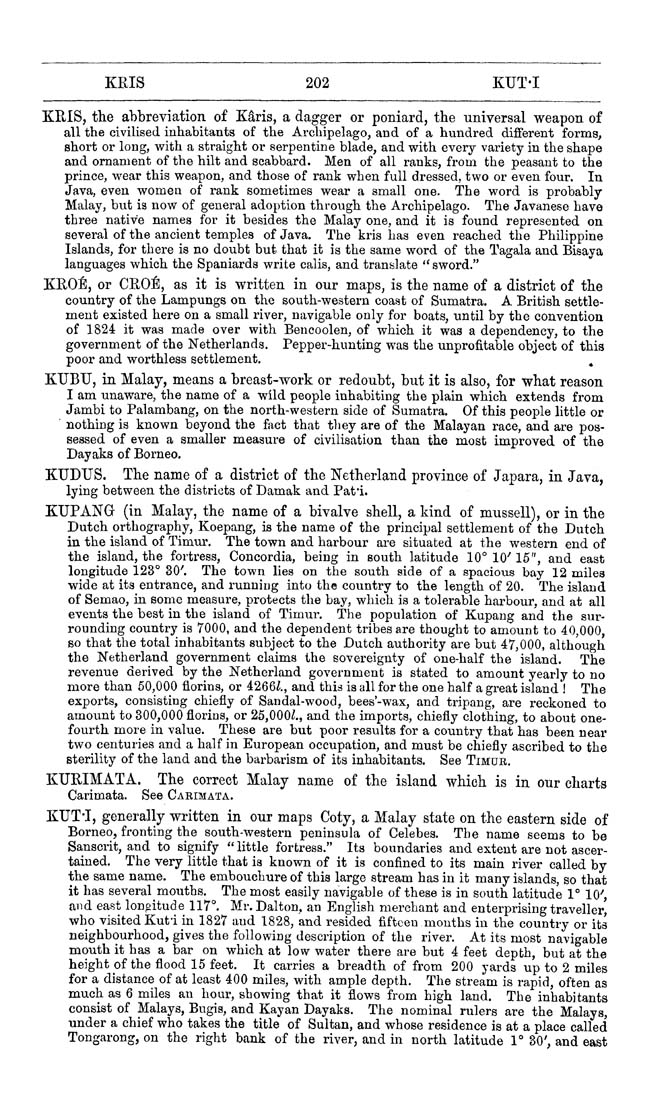KRIS 202 KUT-I
KRIS, the abbreviation of K^ris, a dagger or poniard, the universal weapon of
all the civilised inhabitants of the Archipelago, and of a hundred different forms,
short or long, with a straight or serpentine blade, and with every variety in the shape
and ornament of the hilt and scabbard. Men of all ranks, from the peasant to the
prince, wear this weapon, and those of rank when full dressed, two or even four. In
Java, even women of rank sometimes wear a small one. The word is probably
Malay, but is now of general adoption through the Archipelago. The Javanese have
three native names for it besides the Malay one, and it is found represented on
several of the ancient temples of Java. The kris has even reached the Philippine
Islands, for there is no doubt but that it is the same word of the Tagala and Bisaya
languages which the Spaniards write calls, and translate *' sword."
KROfi, or CR0:E], as it is written in our maps, is the name of a district of the
country of the Lampungs on the south-western coast of Sumatra. A British settle¬
ment existed here on a small river, navigable only for boats, until by the convention
of 1824 it was made over with Bencoolen, of which it was a dependency, to the
government of the Netherlands. Pepper-hunting was the unprofitable object of this
poor and worthless settlement. ^
KUBU, in Malay, means a breast-work or redoubt, but it is also, for what reason
I am unaware, the name of a wild people inhabiting the plain which extends from
Jambi to Palambang, on the north-western side of Sumatra. Of this people little or
nothing is known beyond the fact that they are of the Malayan race, and are pos¬
sessed of even a smaller measure of civilisation than the most improved of the
Dayaks of Borneo.
KUDUS. The name of a district of the Netherland province of Japara, in Java,
lying between the districts of Damak and Pati.
KUPANG (in Malay, the name of a bivalve shell, a kind of mussell), or in the
Dutch orthography, Koepang, is the name of the principal settlement of the Dutch
in the island of Timur. The town and harbour are situated at the western end of
the island, the fortress, Concordia, being in south latitude 10° 10' 15", and east
longitude 123° 30'. The town lies on the south side of a spacious bay 12 miles
wide at its entrance, and running into the country to the length of 20. The island
of Semao, in some measure, protects the bay, which is a tolerable harbour, and at all
events the best in the island of Timur. The population of Kupang and the sur¬
rounding country is 7000, and the dependent tribes are thought to amount to 40,000,
so that the total inhabitants subject to the Dutch authority are but 47,000, although
the Netherland government claims the sovereignty of one-half the island. The
revenue derived by the Netherland government is stated to amount yearly to no
more than 50,000 florins, or 4266Z., and this is all for the one half a great island! The
exports, consisting chiefly of Sandal-wood, bees'-wax, and tripang, are reckoned to
amount to 300,000 florins, or 25,000/., and the imports, chiefly clothing, to about one-
fourth more in value. These are but poor results for a country that has been near
two centuries and a half in European occupation, and must be chiefly ascribed to the
sterility of the land and the barbarism of its inhabitants. See Timur.
KURIMATA. The correct Malay name of the island which is in our charts
Carimata. See Carimata.
KUT-T, generally written in our maps Coty, a Malay state on the eastern side of
Borneo, fronting the south-western peninsula of Celebes. The name seems to be
Sanscrit, and to signify " little fortress." Its boundaries and extent are not ascer¬
tained. The very little that is known of it is confined to its main river called by
the same name. The embouchure of this large stream has in it many islands, so that
it has several mouths. The most easily navigable of these is in south latitude 1° 10',
and east longitude 117°. Mr. Dalton, an English merchant and enterprising traveller'
who visited Kuti in 1827 and 1828, and resided fifteen months in the country or its
neighbourhood, gives the following description of the river. At its most navigable
mouth it has a bar on which at low water there are but 4 feet depth, but at the
height of the flood 15 feet. It carries a breadth of from 200 yards up to 2 miles
for a distance of at least 400 miles, with ample depth. The stream is rapid, often as
much as 6 miles an hour, showing that it flows from high land. The inhabitants
consist of Malays, Bugis, and Kayan Dayaks. The nominal rulers are the Malays,
under a chief who takes the title of Sultan, and whose residence is at a place called
Tongarong, on the right bank of the river, and in north latitude 1° 30', and east
|








